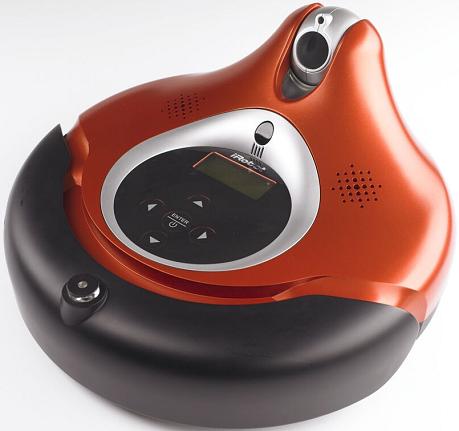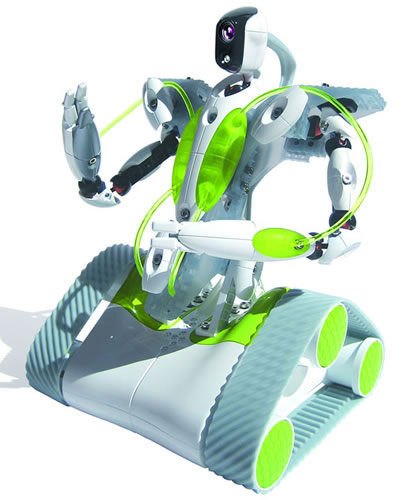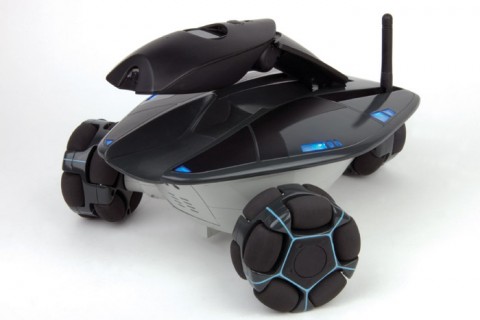With the growth of the Internet, and wireless extensions of the Internet (via Wifi and broadband wireless), it is inevitable that we are going to see our abilities to participate in remote events enhanced through telepresence. There are numerous companies working in this area for “high-end” solutions … Cisco being one of them. But what is now facinating is the growth from the bottom up … the small, inexpensive “toys” that are beginning to show up in the market.
Telepresence is the ability to be present somewhere else … so that you can interact with the world at that remote location without actually being there. Companies like Cisco are working on this for various communications solutions … so that you can have virtual meetings or present at a conference when you are not actually there.
 Last week I found the iRobot ConnectR which is an impressive start. The ConnectR is referred to as a Virtual Visiting Robot and is built on the same iRobot Roomba vaccum platform. It is able to leverage all of the features of that platform, including the transport, navigation, and auto-recharge/dock features … but probably without the vacuum. What has been added instead is a tilting webcam, microphone, and speakers … along with a Wifi wireless radio. Once you have purchased this unit, you can put the charging station in a corner, and then remotely – either from your home, or across the globe – connect to the ConnectR. You can then “drive” it around your house … looking through the webcam, and listening through the microphone … and then even talk to anyone or anything that might be around. You could be using this to check on your house, your pets, your children, or even your parents. And yes … iRobot is already exploring the various issues of security, and how you control access to the ConnectR remotely … and also how you can locally disable the robot. This robot is currently in pilot/beta, and is estimated to cost $499.99 … so not the cheapest … but as an owner of a Roomba I can guess the quality will be there.
Last week I found the iRobot ConnectR which is an impressive start. The ConnectR is referred to as a Virtual Visiting Robot and is built on the same iRobot Roomba vaccum platform. It is able to leverage all of the features of that platform, including the transport, navigation, and auto-recharge/dock features … but probably without the vacuum. What has been added instead is a tilting webcam, microphone, and speakers … along with a Wifi wireless radio. Once you have purchased this unit, you can put the charging station in a corner, and then remotely – either from your home, or across the globe – connect to the ConnectR. You can then “drive” it around your house … looking through the webcam, and listening through the microphone … and then even talk to anyone or anything that might be around. You could be using this to check on your house, your pets, your children, or even your parents. And yes … iRobot is already exploring the various issues of security, and how you control access to the ConnectR remotely … and also how you can locally disable the robot. This robot is currently in pilot/beta, and is estimated to cost $499.99 … so not the cheapest … but as an owner of a Roomba I can guess the quality will be there.
 Yesterday on my way home from Oakland, California I was flying on Southwest Airlines and found yet another iteration of the commodity telepresence robot … and this one is also very impressive. It’s being promoted as a “toy” byt Erector … yes, the folks that used to make Erector Sets. Erector has since been bought by Nikko, an innovative manufacturer of electronic toys … which are growing rapidly in capabilities. The Spykee Robot is a base platform with treaded tracks containing a Wifi radio and basic processor. This basic platform is designed to allow the owner (uh … not just kids … I want one!) to build a “torso” using Erector Set parts. There are supposed to be three models coming … with slightly different parts … and I’m sure a bunch of add-on kits. On the torso is again a webcam, speakers, a microphone, and various lights. The Spykee also has a PC “control panel” application that allows you to remotely – in your house, or across the globe – connect to the Spykee and cruise around interacting with the world. There is also a “security” feature which allows the Spykee to be watching via it’s webcam, and to e-mail you photos when motion is detected. The Spykee appears to be close to shipping in the UK … Amazon says that the US availability is November 15th … list price of $299.99.
Yesterday on my way home from Oakland, California I was flying on Southwest Airlines and found yet another iteration of the commodity telepresence robot … and this one is also very impressive. It’s being promoted as a “toy” byt Erector … yes, the folks that used to make Erector Sets. Erector has since been bought by Nikko, an innovative manufacturer of electronic toys … which are growing rapidly in capabilities. The Spykee Robot is a base platform with treaded tracks containing a Wifi radio and basic processor. This basic platform is designed to allow the owner (uh … not just kids … I want one!) to build a “torso” using Erector Set parts. There are supposed to be three models coming … with slightly different parts … and I’m sure a bunch of add-on kits. On the torso is again a webcam, speakers, a microphone, and various lights. The Spykee also has a PC “control panel” application that allows you to remotely – in your house, or across the globe – connect to the Spykee and cruise around interacting with the world. There is also a “security” feature which allows the Spykee to be watching via it’s webcam, and to e-mail you photos when motion is detected. The Spykee appears to be close to shipping in the UK … Amazon says that the US availability is November 15th … list price of $299.99.
 While investigating the Spykee, of course I came across the Wow Wee Rovio. This is another $299.99 remote telepresence robot, with a browser based control panel. The three wheeled unit contains the processor, Wifi radio, webcam, microphone and speaker, along with some sort of optical tracking – similar to the iRobot units. There is a docking station for recharging, and optional tracking beacons that canbe bought – I’m guessing – to enhnace the navigation of the robot around your house. This unit appears to be available now in the US, and I’m surprised I haven’t seen one in the stores yet.
While investigating the Spykee, of course I came across the Wow Wee Rovio. This is another $299.99 remote telepresence robot, with a browser based control panel. The three wheeled unit contains the processor, Wifi radio, webcam, microphone and speaker, along with some sort of optical tracking – similar to the iRobot units. There is a docking station for recharging, and optional tracking beacons that canbe bought – I’m guessing – to enhnace the navigation of the robot around your house. This unit appears to be available now in the US, and I’m surprised I haven’t seen one in the stores yet.
What is impressive is that these last two units are now below $300 for a complete – basic – telepresence robot. The example videos provided by both companies demonstrate both home and office uses, and begin to move into the home security space … and even the home video surveillance space. As we saw with the prices on Wifi Access Points, and other hardware … I can only expect it to continue to fall.
The next area that I am going to look at for these robots, and something that I believe will be important for success, will be the “hackability” of the control protocols. How easy will it be for hackers to begin to enhance the controlling applications, and for the robots to be integrated into more extensive applications? Imagine when someone has created the automatic search and mapping application for the Rovio or Spykee that allows someone to release dozens of these into an unknown building and have the robots quickly survey the inside and report back what they find. What other applications are going to emerge? Maybe I can rent a remote Rovio to explore a remote location that I otherwise might never visit! Explore the Louvre after hours? Visit underground caverns on the other side of the planet? Hmmm … maybe there is a interesting business model in there somewhere … 🙂
